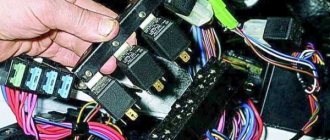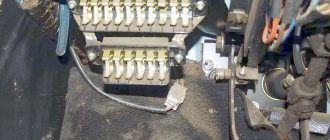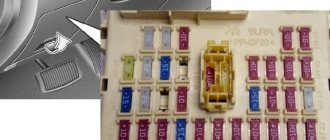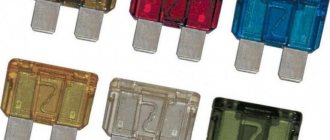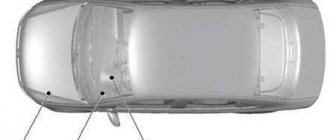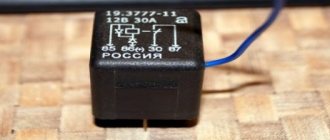Standard Chevrolet Niva fuses are designed to protect the vehicle's electronic equipment. The unit is located in a place rare for modern cars - inside the cabin. There is a safety module installed under the glove box. The box is responsible for the secondary circuits of the equipment and is not directly related to the power plant.
The main engine relay is mounted as a separate unit. On Chevrolet Niva 2017-2019 it is in the form of a plastic cube.
Where are the fuse box and relays of the Niva Chevrolet
The location of the inserts on cars did not change from 2011 to 2022.
To gain access to the main unit, you should pick the instrument panel in the area of the pedal assembly. Under the dashboard, to the left of the steering wheel. To get to the panel under the tidy, use a Phillips screwdriver to remove the plastic casing, where the panel will be.
The next part is located under the glove compartment. To get to the site you will need to completely dismantle the glove box. The installation location was not chosen by chance. The module cover is protected from mechanical damage and moisture, and breakdowns inside are rare. Repair is not difficult.
In the pre-Restyle version, the main unit was located in the engine compartment and the inserts were located under the hood near the ECU, where the main electronic element of the car was installed.
A detailed location with a description is in the photo below.
Chevrolet Niva fuses with description
The main elements of a car can be divided into two groups based on location. Consequently, their purpose will be different.
The photo shows a fuse panel, relevant for models manufactured after 2009.
For convenience, it is better to present the decoding in the form of a table.
| Number | Circuit Description |
| F1 | License plate lighting, side lights on the left side of the car. |
| F2-4 | The main lighting is low beam, high beam and fog lamps on the left side of the car. In some configurations, fuse No. 4 is a spare socket. |
| F5 | Main power window protection relay |
| F6 | Cigarette lighter power supply. Some motorists connect power cores here instead of an incandescent filament. |
| F7 | Horn connection relay. |
| F8 | Heated rear glass and rear view mirrors. |
| F9 | Interior lighting switch, glove compartment lighting, wiper drive and electrics. Separate outlet for windshield washer system compressor. |
| F10 | Standard control module for electrical accessories and door locking, or spare |
| F11-14 | Exterior car lighting. Low and high beam head optics, fog lights, side lights. The fuses are responsible for the right side of the vehicle. |
| F15 | Standard control system for rear view mirror drives. Fuse for heated seats. The minimum configuration does not include the insert. |
| F16 | Hazard warning light breakers and turn relays |
| F17 | Interior lighting, partial display of the instrument panel, alarm position control, brake signals, additional stop block. |
| F18 | Power heating fan |
| F19 | Starter head relay, instrument panel lighting and indication, turn signal relay system in turn mode. |
| F20 | Rear fog lamps, immobilizer and anti-theft alarm buzzer. |
The car radio and speedometer are connected separately from the main fuses. The drives of the injectors and air conditioning compressor are designed similarly. Depending on the configuration and year of manufacture, the listed components may be connected according to a different scheme.
Also in the VAZ 2123 panel there are spare fuses located in separate sockets.
Additional fuse block
The DBP, also known as the engine control panel, is located under the dashboard at the passenger's feet.
To gain access to the unit, you will need to dismantle the glove box. Below it is an auxiliary module. Here the main part is represented by relays, but there are also fuses. Fuse links have markings and areas of responsibility:
- No. 2 – high-power fuse responsible for protecting the power lines of the electrical circuit of the right radiator fan and an additional relay group;
- No. 3 – safety insert for the fuel pump located in the tank;
- No. 4 – the element is responsible for powering the car controller circuit;
- No. 9 – fuse for the right radiator fan;
- No. 10 – insert protecting power lines and circuits switched on by the main relay.
Relay Niva Chevrolet
Two places where protective inserts of electrical circuits are concentrated are presented. The explanation of the automatic circuit switching nodes is as follows.
Main mounting block.
| Designation in the diagram | Decoding of the serviced circuit and equipment |
| K1 | Mostly not used, but in some configurations it can be connected. |
| K2 | Window cleaning system, relay powers electric motor. |
| K3 | Turn signal breaker in working position |
| K4 | Headlight module - low beam switching on |
| K5 | Protective switch for turning on and powering the high beam head optics |
| K6 | An additional relay is responsible for the operation of several nodes simultaneously. Typically, the heated glass of the aft part, the fan drive of the heating system, and the windshield and rear window washers are connected here. |
| K7 | In some configurations it acts as a fuse for the heating element of the cargo compartment door. |
| K8 | Not used |
The car’s design also includes a remote control panel:
- K1/2 – standard fog lights (if equipped);
- K3 – activation of the seat heating system;
- K4 – horn protection;
- K5 – standard inclusion of the starter circuit.
Separately, you should consider the engine control system unit:
- K1 – additional relay;
- K5-6 – head radiator fan inserts for the left and right sides, respectively;
- K7 – power supply to the fuel pump circuit;
- K8 is the main relay of the car.
System structure and principle of turning on fans
Everything works as follows.
- The radiator and engine block are looped into a single system using pipes. Between them there is a rheostat - a damper with a temperature-sensitive element inside.
- When a certain temperature is reached, the damper opens and the liquid begins to circulate in a large circle.
- If passive cooling fails, the engine temperature rises. The head cooling fans come into play. When the temperature limit is overcome, the DTOZh sends an impulse to the BC.
- The processed signal closes the relay and the fan turns on. To improve system performance, the devices are paired. Dubbing helps prevent overheating if one of the devices breaks down. At the same time, the connection diagram for active coolers implies their simultaneous and separate activation.
The Chevrolet Niva interior heater fan is also used to cool the engine. Part of the system has a slight effect on the temperature, but in an emergency it can affect the operation of the engine.
Schnivy fuse and relay diagram
The electrical circuit is not particularly complex or confusing. The abundance of simple equipment, mainly without feedback, does not overload the electrical circuit.
A separate element is the electrical package unit numbered 1118 6512010. The part is installed optionally and exclusively in certain configurations. Cars equipped with electrical accessories have a complicated circuit. The electrical circuit of the car has terminals for a trailer, a portable socket, and a towbar terminal connection. All network elements and nodes are powered through the instrument cluster, which makes troubleshooting easier.
Cigarette lighter fuse Niva Chevrolet
Due to the “excellent stability” of the domestic manufacturer, replacing the cigarette lighter fuse on a car always presents more problems than on similar imported cars.
The main problem is the constant transfer of the fuse link to different places. Consequently, when a part burns out, its replacement is accompanied by a search for the required joint throughout the machine. The photo shows the required fuse in the 2010 car modification.
For machine versions 2006, 2007, 2014 and 2022, the location of the element may differ.
The guard often fails; some drivers change the electrical circuit of the car for the sake of operating comfort. Users power the cell directly from the battery and insert a powerful fuse into the circuit. This manipulation makes it easier to repair the unit and makes it possible to strengthen the structure for connecting energy-intensive devices such as charging for a laptop, vacuum cleaner or fan.
Window control unit
On models 2009 and 2013 (after restyling), the electrical circuit looks like this.
Here the pinout of the devices is as follows.
- 1 – fuse mounting block;
- 2 – window regulator activation relay;
- 3/6 – electric drive switches for the front left and right doors, respectively;
- 4/5 – directly the gear motor for the left and right mechanisms, respectively.
If the fuse responsible for the device is constantly on, the problem may be hidden in a shorted motor or control button. The device should be tested and damaged elements replaced.
The device is not supplied in separate configurations by the factory. But you can easily install it yourself. The price of the head module of the power window control system starts from 800 rubles. The average price tag on the market is 1000-1200.
Where is the Niva Chevrolet alarm unit located?
The car is delivered to the market equipped with a standard anti-theft system. There is a door lock and an immobilizer, and it is also possible to sound a sound signal. All elements of the chain are securely hidden from prying eyes.
Two-way communication provides the driver with a response when trying to open or steal a car. If intruders try to steal a car, the corresponding indicator on the key fob will light up and a beep will sound.
The disadvantages of factory anti-theft systems are typical problems for the domestic automobile industry - low reliability of modules and frequent failures. Some car enthusiasts complain that the brake light does not work or the emergency lights do not turn on (when they try to break into the car, the car does not show signs of life).
To solve the problem, car enthusiasts install another alarm and connect it to the standard connector. To perform this operation, disconnect the factory box located under the fuse mounting block.
Shnivy stove control unit
It is a closed panel with remote controls and keys.
At the same time, the design of the device from 2004 and the version after the 2012-2016 restyling has not changed. There is a fan rotation control at 4 speeds and heating intensity control. There is also a knob for distributing air flow into individual zones. In some cases, the user needs to repair the module, which means removing and replacing it, or modifying it. Usually the cause of a breakdown is a burnt-out resistor or broken rods.
To remove the heater control panel you will need to perform a number of steps.
- The first step is to disconnect the terminal from the battery.
- Next, we go into the interior and, holding the fan position regulator, you need to pull it towards you until the last one comes out of the groove.
- Then disconnect the other adjustments in the same way and disconnect the rod lever.
- Next, armed with a flat-head screwdriver or similar object, you need to pry off the plastic clips of the device cover.
- After snapping the clips, the panel will disengage and can be removed in the same way as the handles.
- The last stage is to disconnect the wiring joints.
- Assembling the air heating system is carried out in the reverse order.
You can see in detail how to dismantle the stove drive in the video.
Turning relays and fuses
In the standard diagram it is presented under No. 16 of the main mounting block. It looks like a standard fuse link. On cars up to and including 2008, the emergency light fuse was located separately, but a new circuit installed by car enthusiasts corrected the situation.
The system also has a protective relay-breaker. The element is located in the main mounting block under number K3. When the switch burns out or fails, the lights begin to blink faster than usual or stay on constantly. The location of the relay has been chosen well - replacing it is not difficult even in a garage.
The main malfunctions of the system arise precisely in these elements, but there are also breakdowns of the steering column switch.
Relay and fuse for size Niva Chevrolet
In the system of cars after 2008, insertion F1 of the main mounting block is responsible for the operation. The right side is powered through fuse F14.
Elements often fail due to moisture getting on the contact group of the lamps and their damage - the placement of optical devices affects it.
Ignition unit
The main module is a separate block.
The device is located on the engine and is secured with screws. The part has a simple purpose - adjusting the timing of the spark depending on the general condition of the motor. When the circuit begins to fail, it must be completely replaced - the panel cannot be repaired.
There is no part on carburetor cars produced in 2005. The following information is valid for the newer version.
The unit is disconnected after disconnecting the battery using head No. 10. Before manipulation, it is recommended to disconnect the high-voltage conductors and the contact group of the ECU. Installation is performed in reverse order.
Chevrolet Niva warning lamp unit: description
After the 2015 release, there is an updated module that indicates the status of the vehicle systems in real time. The lamps are located next to the buttons or placed separately on the dashboard.
There are a total of 7 indicators on the standard diagram.
- The center differential lock activation icon lights up only when the mechanism is activated.
- Used for standard immobilizer.
- Indicates a leak in the power steering system.
- A simple designation is the activation of the ABS complex. It may also indicate a puncture of one or more wheels.
- Triggering of the SRS system.
- The requirement to check the engine, or can act as an indicator of the level of brake fluid in the reservoir.
- Lights up when seat belts are not fastened.
Niva Chevrolet: reverse sensor
The electronic part is mounted on the rear of the gearbox housing and is responsible for the operation of the reverse lights. Periodically, the device fails and the system produces incorrect data. This is caused by unfavorable placement of the device on the machine. The part is constantly exposed to dirt, dust and obstacles on the road can interfere.
Replacing the sensor is simple. To perform the operation, just follow the procedure:
- pull off the sensor power terminal;
- unscrew the sensor from its seat;
- Install the new one in reverse order.
Chevrolet Niva central locking unit
It is an electronic module that connects door lock drives. The part often fails due to a blown fuse or a short circuit in the door wiring.
The photo shows the standard central locking pinout for the most common versions of the car.
- directly the mounting block.
- BOO.
- Reducers for blocking aft passenger doors.
- Same for the front passenger door.
- Accordingly, the driver's part with the corresponding conclusion.
Comfort block
Another name is the electrical package control unit. The module is in the form of a plastic box with circuits located in it. On the lower part there are contact groups for connecting window regulators and regulators.
The device is modular and cannot be repaired if it breaks down. Regardless of the version and configuration of the machine, it is located behind the main fuse mounting block.
Shnivy headlight block
The modern modification of the new model is equipped with a modular lighting unit.
The part is responsible for supplying high and low beams. There is also a daytime running light or DRL lamp. It is noteworthy that there is no connector for fog lights. The headlight is simply not designed for the installation of additional elements. Installation of fog lights is carried out separately.
The autolight device is simple. There is a contact group of wires, lamps, a reflector and everything is like a standard modern device. Thanks to the modernization of optics and the installation of efficient light bulbs, the PTF system is not needed to provide normal lighting.
Charging relays and fuses
Users access the nodes when the battery is not charging. Depending on the age of the car, the battery protection is installed on the right fender liner near the battery or generator. Also, due to the “whims” of the manufacturer, the part can be located anywhere. Searches are usually carried out in the wiring section between the battery and the generator.
If the problem is in the relay, it should be changed completely. The node cannot be restored.
Shnivy immobilizer unit
The standard immobilizer on the Niva is part of the security system and is responsible for blocking the engine during an attempt to steal it.
The specified car is supplied to the market with the standard APS-6 model. Modification in the form of a simple design with increased reliability. The unit is housed in a metal case, which helps protect it from mechanical damage and shock. The protective module is mounted under the plastic cover of the center console. It is easy to recognize - contacts coming out from the installation are connected to the engine control system, which allows you to block its operation and starting.
Chevrolet Niva wiper fuses and relays
In the standard unit, insert F9 is responsible for the operation of the windshield wiper. You can change it with special tweezers. The wiper relay number K2 is a more complex unit. The design with adjustable response time allows you to maintain pauses between flashing bulbs.
The breaker is located in the mounting block. If the insert is damaged or faulty, replace it. The part is not repairable.
Chevrolet Niva mirror control unit
Most old-style machines in use do not have such an option. In new versions, the unit is installed from the factory and is a convenient addition.
The module is powered by fuse No. 5 and relay index K4. If the mirror adjustment does not work or responds intermittently, they should be checked.
The heating and adjustment system is activated only when the ignition is turned on. When trying to adjust the mirrors without a key, nothing happens - this is normal.
Fuses and relays for windshield wipers
Inserts F9 and K2 are responsible for the operation of the windshield washer. They also prevent the rear window sprayer pump, if equipped, from overloading.
There are no special features in the design. The parts are included in the circuit after the switch and can be easily replaced with new ones.
Chevy Niva window control unit
Located on the center console in the armrest area. Some modifications are equipped with a regulator mounted in the door niche.
A common problem is system failure. If the lift is burnt out, it should also be replaced entirely.
Solenoid relay
Similar to all other models, it is located on the body of the part and is responsible for the clutch of the flywheel with the “starter”. A typical breakdown is when, when trying to start the engine, there are no characteristic clicks similar to the clatter of fingers.
To replace, you will need to remove the starter from the car and disassemble it. Also, some experts recommend simultaneously inspecting the starter.
Front axle disconnect unit
The front-wheel drive deactivation system is of particular interest. Mechanical structure device, mounted separately. The part is not installed from the factory - the car only has all-wheel drive.
Due to the design features of the Shniva, before finding out the article number for ordering, you should study the box model. On different modifications, the seats may differ slightly, which will lead to oil leaks from the gearbox.
A similar system on the Internet has controversial reviews. Some users claim that fuel consumption decreases and top speed increases. Opponents of the modification speak out about increasing the load on the rear axle.
Climate control unit
The module is installed on cars exclusively in the Luxury configuration. The device is not available to most owners.
The unit is directly connected to the cooling system and regulates the distribution, temperature and intensity of air flow into the cabin.
Injection system relay and fuse box
The part is located directly on the power plant and is part of the ECM. If the device fails, the engine may stutter, sneeze, lose dynamics, or the engine refuses to start.
Diagnosis of the problem is carried out by the scanner through the appropriate connector. After finding the problem, it is recommended to replace the entire assembly.
Removal and replacement process
Required Tool:
- 10 mm socket head,
- tweezers,
- Phillips screwdriver;
To replace a fuse or relay, you need to:
- Turn off the ignition and disconnect the negative terminal of the battery.
- For the main unit: unscrew the two screws securing the cover;
- press the top edge of the cover and remove it from the instrument panel fastenings;
- pull the cover towards you and remove it;
- pull out the broken part with tweezers or your hand.
- remove the plastic casing in the area of the front passenger's feet by unscrewing the nut with a 10mm socket;
- remove the left screen of the instrument panel console, located near the driver’s right foot, by removing five screws;
Reasons for failure of shnivy fuses
Inserts burn out due to the following reasons:
- short circuit in the serviced circuit;
- sudden voltage surge;
- wiring damage;
- violation of cable insulation;
- installation of too powerful equipment.
Due to the failure of the fuses, the engine may not start, and the serviced unit completely breaks down.
A burnt out relay behaves similarly. The insert does not click when tested, the powered circuit is completely de-energized.
Pulley fan sensor
The coolant temperature sensor plays the role of supplying a pulse to turn on the fans. When a certain temperature is reached, the device sends a signal to the ECU and the fans are activated. In versions where the BC is located in the cabin, you can make adjustments to the sensor response threshold.
Purpose and functions
The device has a single role - to prevent boiling of the coolant and overheating of the power plant. Thus, turning on at a certain moment, the part equalizes the temperature of the engine and stabilizes its behavior.
Operating principle and location
The sensor works as follows.
- The temperature-sensitive sensor is programmed to pulse at a certain temperature.
- When the threshold is reached, the sensor sends a signal to the ECU and the first fan turns on.
- If the motor temperature rises further, the second relay is activated and the remaining fan is connected.
How to install an additional cigarette lighter
The number of mobile devices used during the operation of the VAZ-21214, especially during long trips or family trips, can reach 5 or more units. It is impossible to charge phones or use a navigator when the cigarette lighter does not work. To avoid unforeseen situations, you must use an additional splitter for several charging sockets.
For the convenience of passengers, it is customary to install a parallel socket-splitter between the front seats instead of cup holders or in the immobilizer tunnel. After installation and fastening, the wires of the additional socket are connected parallel to the standard one. The connection points are reliably isolated.
- Cigarette lighter Lancer 9
- Cigarette lighter fuse Renault Logan
- Chevrolet Lacetti cigarette lighter fuse
- The best car seats for children
Additional block under the glove box
Located under the glove box on the passenger side.
| Number | What is he responsible for? |
| 1 | Additional relay (turns on the right electric fan through an additional resistor at low rotation speed) |
| 2 | Fuse (50A) protecting the power circuits of the additional relay and the right electric fan relay |
| 3 | Fuse for the fuel pump (fuel pump) (15A), protecting the power circuits of the electric fuel pump relay |
| 4 | Fuse (15A) protecting the controller's constant power supply circuit |
| 5 | Right electric fan relay |
| 6 | Left electric fan relay |
| 7 | Fuel pump relay |
| 8 | Main relay |
| 9 | Fuse (50A) protecting the left electric fan circuits |
| 10 | Fuse (15A) protecting power circuits switched on by the main relay |
| 11 | Controller |
→ Choose the best MTPL from all insurance companies on Sravni.ru! You can save up to 3,000 ₽
→ Map for motorists Tinkoff Drive! Bonuses: 10% on purchases at any gas station, 5% for car services (wash, car service, parking). From 0 ₽ per month - cost of service.
Replacing fuses
Before replacing an element, it is necessary to eliminate the cause of its failure. Do not use fuses of a different rating. The calculated current strength for each circuit can be found in the assignment table located above in the article.
The protective device may fail due to long periods of use, so if any consumer stops working, the first thing to check is its fuse.
They are held in their nests by sliding contacts. In order to remove the element, simply pull it out of the socket. To make this more convenient, modern mounting blocks are equipped with plastic tweezers.
A faulty fuse can be determined by visual inspection or using an ohmmeter. Since the housings are made of transparent plastic, the integrity of the conductor is easy to determine with the naked eye. In addition, conductor burnout is accompanied by an increase in temperature. Traces of heat exposure remain on the plastic case. Having selected an element suitable for its nominal value, it is inserted into the socket in place of the failed one.
In no case should you use bugs instead of a fuse, as they may not burn out when the current increases, which will lead to overheating and fire of the wiring.
If a fuse burns out on the road, you can replace it with an identical one that protects the circuit of the consumer that is not currently in use.
More information about Chevrolet Niva electronics can be found here.
Where are the fuses located in the Chevrolet Niva? Fuses and relays (2) are located in the block, mounted on special brackets under the instrument panel to the left of the steering column and secured with a cover from below. To gain access to the Chevrolet Niva fuse box, you need to remove its cover by unscrewing the screws.
Job
The Shniva cooling system has two active cooling elements. There is a fan for the heater radiator and the main heat exchanger. The following information is relevant for cars of 2010 and other model years.
Fuses are responsible for the correct, stable operation of devices. Fuse links will protect the device from power surges and short circuits.
Pulley fan fuse: where is it located?
Located in close proximity to the corresponding relays. The stove insert is located in the main mounting block under number F18. A 25 amp fuse protects multiple circuits at once.
Video “How to change Chevrolet Niva fuses”
Another video of replacing fuses and relays on a Chevrolet Niva was shot by Igor Pokhabov.
The connection diagram for electrical consumers of a Chevrolet Niva car is a set of parallel-connected circuits, each of which is protected by a fuse. This distribution allows you to create circuits designed for their rated current value. For convenience, all fuses and relays are displayed on a single panel. The Chevrolet Niva fuse box is located under the center console on the driver's side.
Mounting block diagram
Since there are no markings on the fuse box cover of the Chevrolet Niva, we suggest you use the following hint.
Fuse and relay block diagram.
PTF relay
The PTF relay is indicated in red.
The PTF relay in the block is indicated by a red arrow.
«>
How to change fuses?
To change the fuse links in the Niva Chevrolet fuse box, you need to understand the electrical circuit of the car. A failed fuse can be identified visually or using a tester. To do this, turn on the device in the closed circuit sound test mode and install the probe tips on the fuse contacts.
Test procedure and tweezers
The replacement itself, for example, a windshield wiper fuse with a rating of 20 A (position F9 on both blocks), is carried out as follows:
- Open the block cover.
- Find the failed insert.
- Take it with tweezers and pull it out of the nest.
- A fuse of the same rating must be installed instead. The use of inserts of a higher rating can lead to burnout of the unit and electrical wiring, as well as to a vehicle fire. Using parts with a lower rating will also not protect the circuit, since such an insert will immediately burn out.
- Turn on the circuit in which the insert was replaced. If re-burnout occurs, then the problem is in the elements of this circuit.
- Place the tweezers in their original place and close the lid.
The process of replacing one of the fuses is shown in the video from the Remgar channel.
How to remove and disassemble the cigarette lighter
The cigarette lighter along with the ashtray is located in a retractable compartment in the middle of the “torpedo”; it consists of 2 parts - a socket and a remote socket with a nichrome filament.
It will not be possible to disassemble the remote cartridge - it is a solid, non-repairable part.
If the cause of the breakdown lies in the socket, the element is dismantled and replaced according to the following algorithm:
- the electrical busbar is removed from the battery, which connects the negative terminal;
- the remote injector is removed from the socket;
- it is compressed until it comes out of the grooves and the protective screen of the socket is removed;
- use a screwdriver to press the latch and remove it from the mounting groove;
- the socket that needs to be replaced is removed from the groove along with the wiring;
- the wires are disconnected, the socket is dismantled.
During dismantling, care must be taken not to injure yourself with a flat-head screwdriver.
How to repair
If a connected external device in a working outlet causes sparking, this is a sign that the contact blades do not have a reliable connection with the remote socket. Due to the “slack” created as a result, the fuse link will burn out. You need to arm yourself with a flat-head screwdriver, a flashlight and bend the contact petals, which are located at the bottom of the socket. When the petals are heavily charred, the entire device should be replaced.
